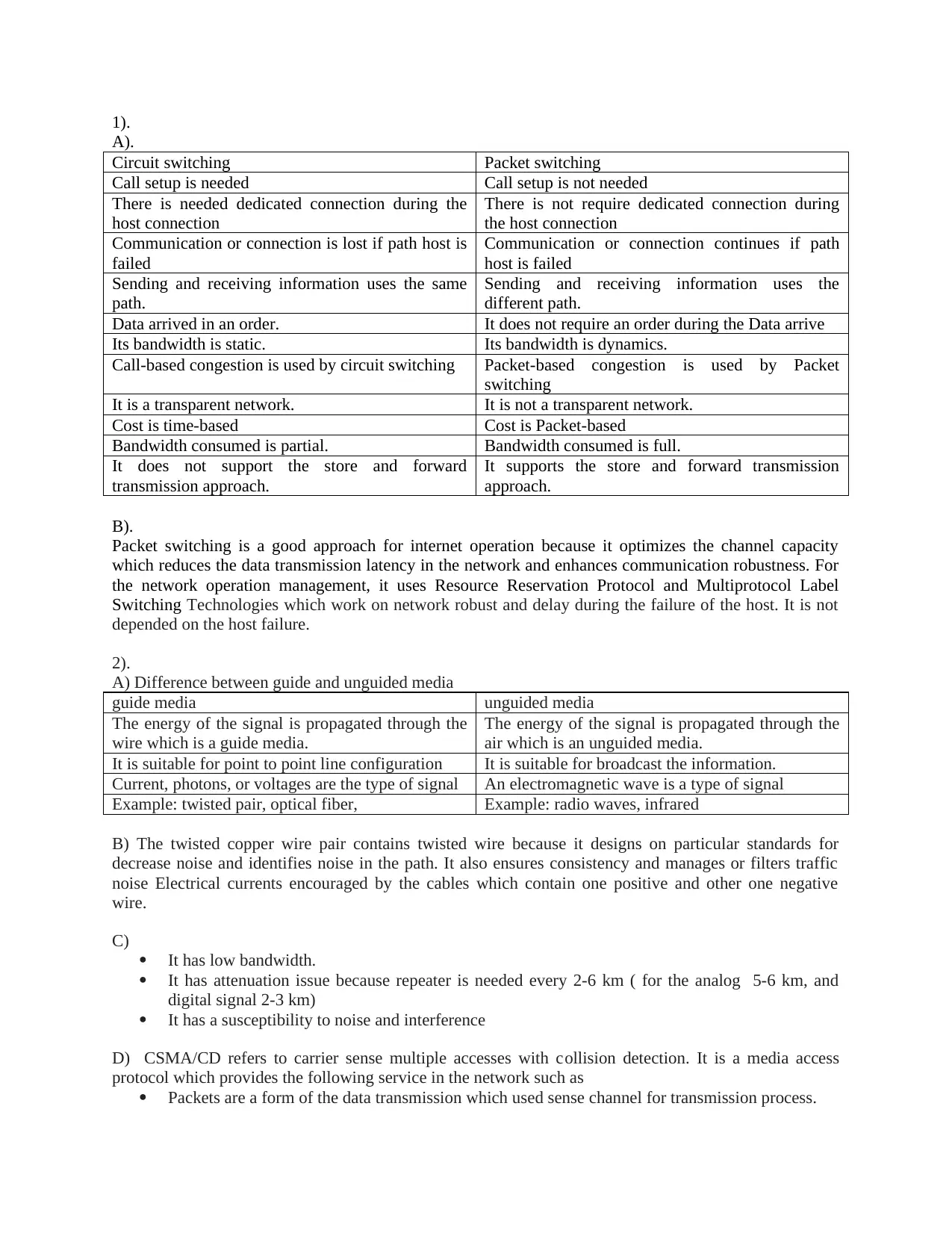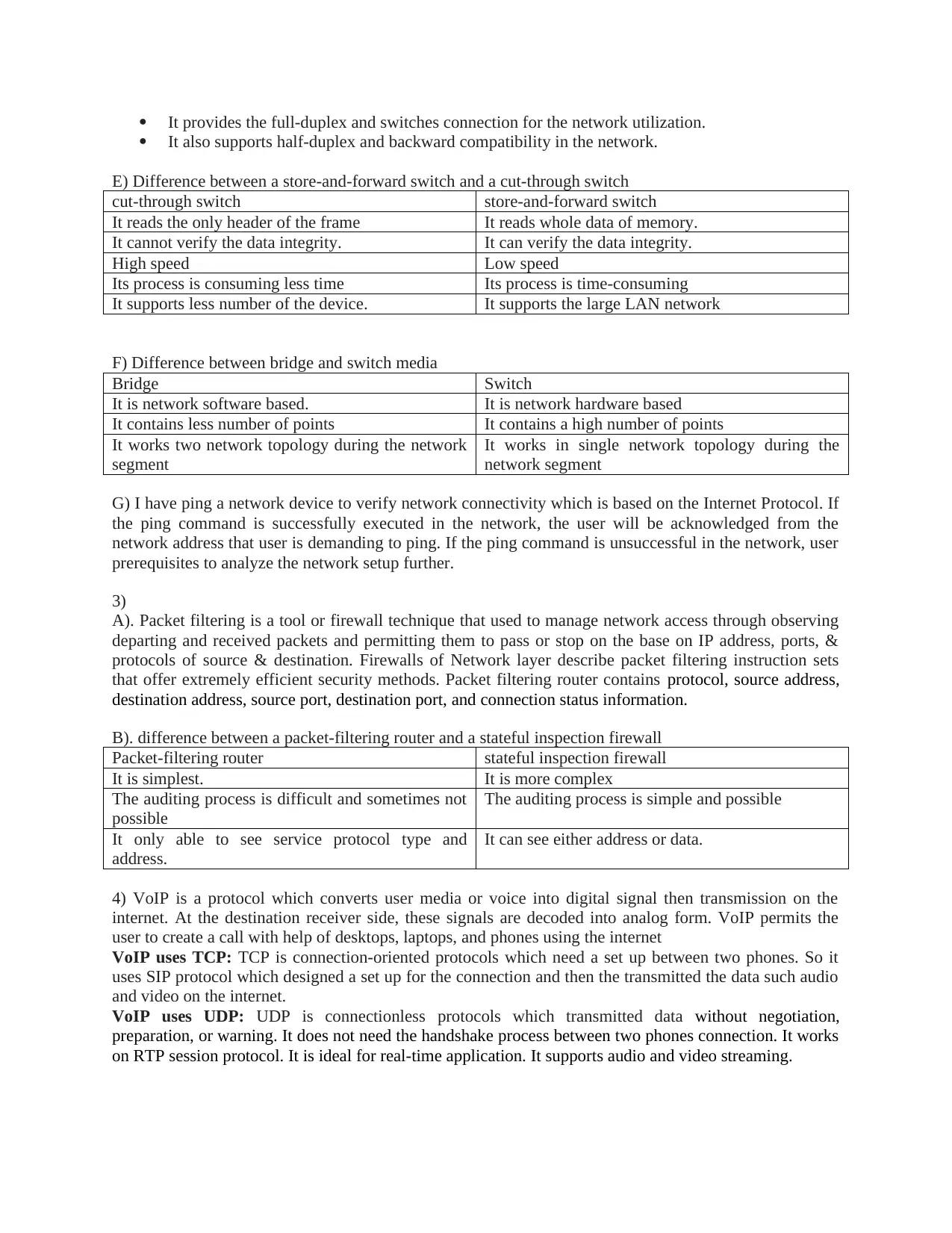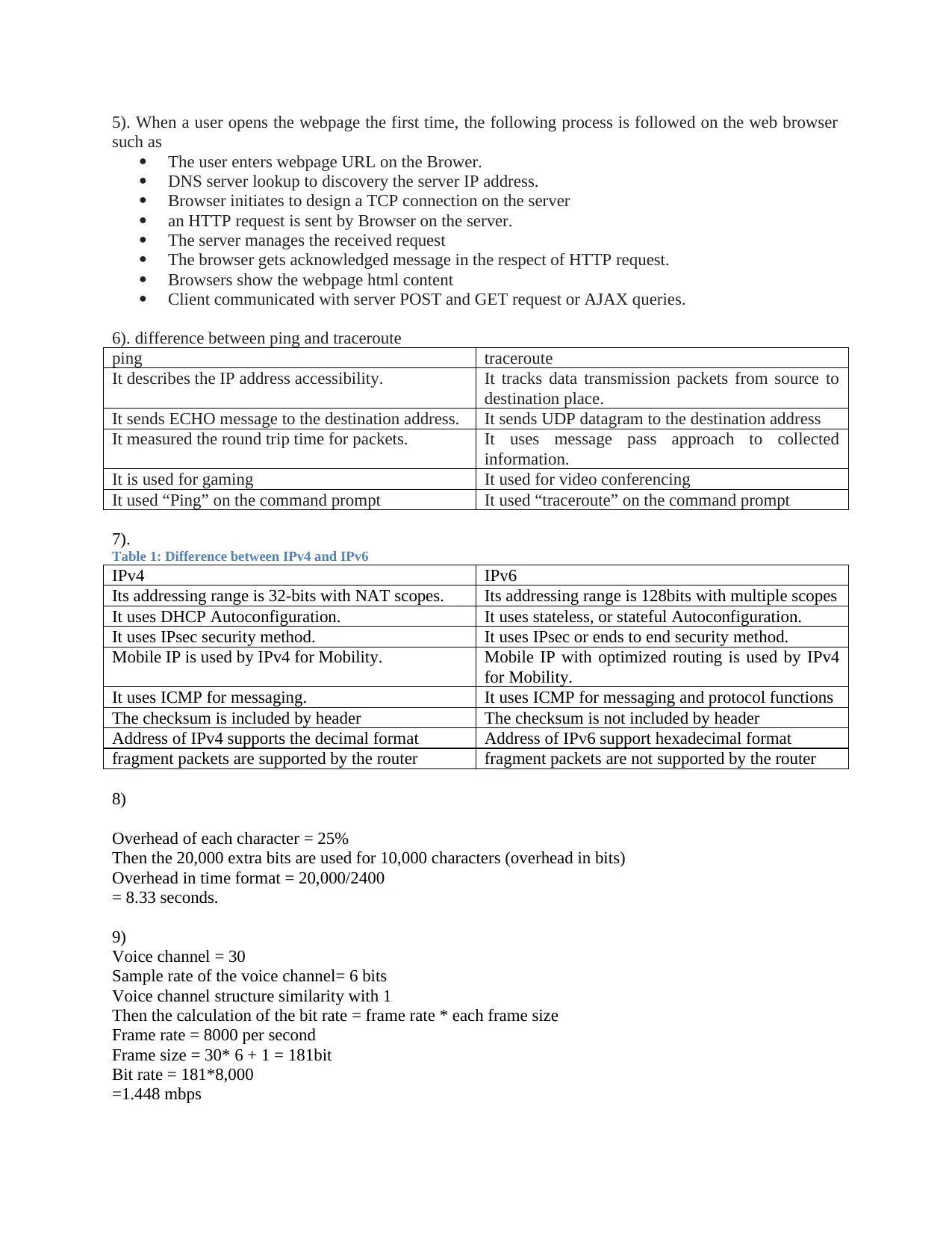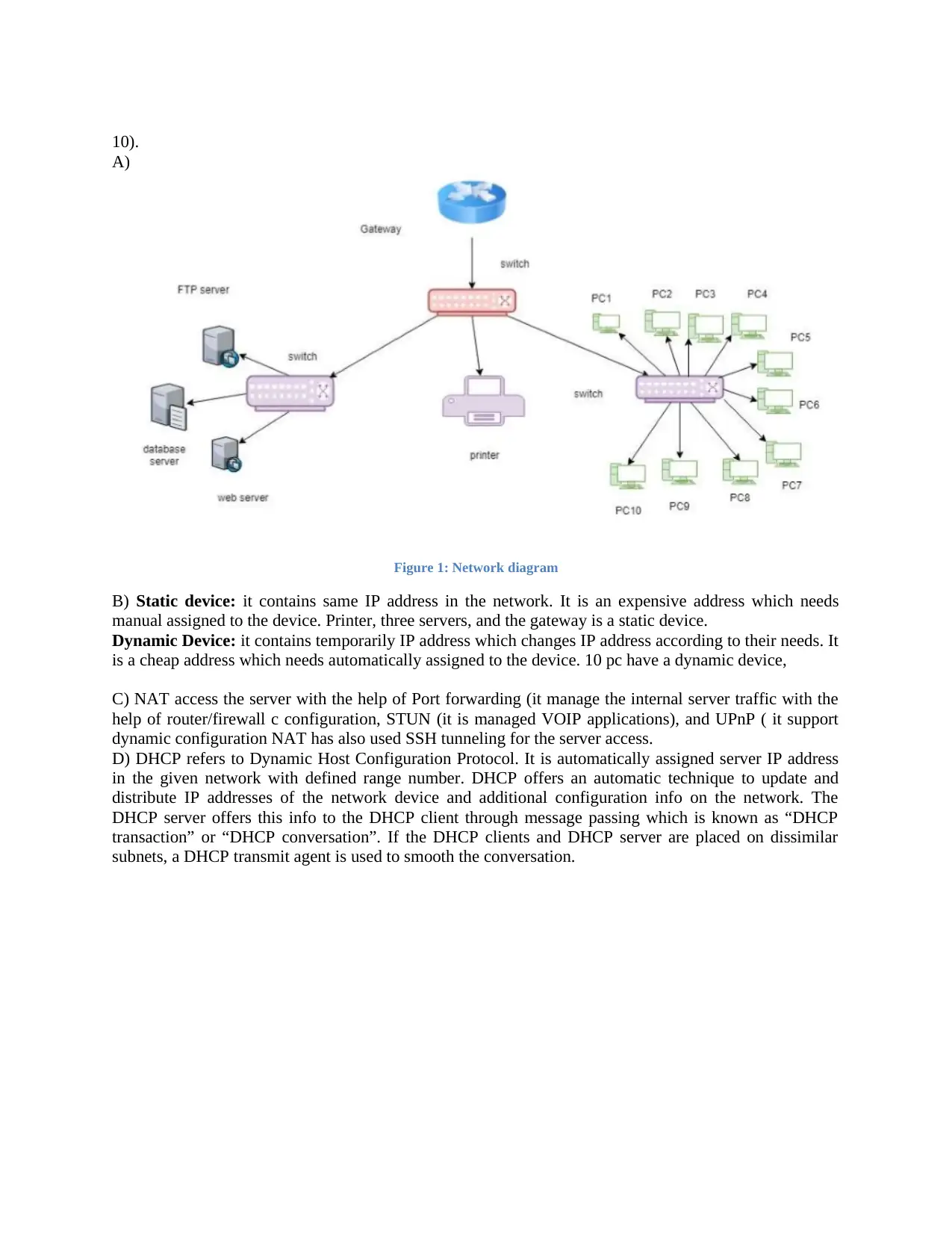Network Switching, Media Transmission, and Security - An Overview
VerifiedAdded on 2024/06/04
|4
|1655
|493
Homework Assignment
AI Summary
This assignment provides a detailed comparison of circuit switching and packet switching, highlighting their differences in call setup, connection requirements, data transmission, and bandwidth usage. It also examines guided and unguided media, including twisted copper wire pairs, and discusses the CSMA/CD protocol. Furthermore, the assignment differentiates between store-and-forward and cut-through switches, as well as bridges and switches, and explains the use of ping for network connectivity verification. It covers packet filtering techniques, compares packet-filtering routers with stateful inspection firewalls, and discusses VoIP protocols using TCP and UDP. The assignment also outlines the process of accessing a webpage, contrasts ping and traceroute, and compares IPv4 and IPv6. Finally, it includes calculations related to overhead and bit rates in voice channels and provides a network diagram illustrating static and dynamic devices, NAT access methods, and the role of DHCP.

1).
A).
Circuit switching Packet switching
Call setup is needed Call setup is not needed
There is needed dedicated connection during the
host connection
There is not require dedicated connection during
the host connection
Communication or connection is lost if path host is
failed
Communication or connection continues if path
host is failed
Sending and receiving information uses the same
path.
Sending and receiving information uses the
different path.
Data arrived in an order. It does not require an order during the Data arrive
Its bandwidth is static. Its bandwidth is dynamics.
Call-based congestion is used by circuit switching Packet-based congestion is used by Packet
switching
It is a transparent network. It is not a transparent network.
Cost is time-based Cost is Packet-based
Bandwidth consumed is partial. Bandwidth consumed is full.
It does not support the store and forward
transmission approach.
It supports the store and forward transmission
approach.
B).
Packet switching is a good approach for internet operation because it optimizes the channel capacity
which reduces the data transmission latency in the network and enhances communication robustness. For
the network operation management, it uses Resource Reservation Protocol and Multiprotocol Label
Switching Technologies which work on network robust and delay during the failure of the host. It is not
depended on the host failure.
2).
A) Difference between guide and unguided media
guide media unguided media
The energy of the signal is propagated through the
wire which is a guide media.
The energy of the signal is propagated through the
air which is an unguided media.
It is suitable for point to point line configuration It is suitable for broadcast the information.
Current, photons, or voltages are the type of signal An electromagnetic wave is a type of signal
Example: twisted pair, optical fiber, Example: radio waves, infrared
B) The twisted copper wire pair contains twisted wire because it designs on particular standards for
decrease noise and identifies noise in the path. It also ensures consistency and manages or filters traffic
noise Electrical currents encouraged by the cables which contain one positive and other one negative
wire.
C)
It has low bandwidth.
It has attenuation issue because repeater is needed every 2-6 km ( for the analog 5-6 km, and
digital signal 2-3 km)
It has a susceptibility to noise and interference
D) CSMA/CD refers to carrier sense multiple accesses with collision detection. It is a media access
protocol which provides the following service in the network such as
Packets are a form of the data transmission which used sense channel for transmission process.
A).
Circuit switching Packet switching
Call setup is needed Call setup is not needed
There is needed dedicated connection during the
host connection
There is not require dedicated connection during
the host connection
Communication or connection is lost if path host is
failed
Communication or connection continues if path
host is failed
Sending and receiving information uses the same
path.
Sending and receiving information uses the
different path.
Data arrived in an order. It does not require an order during the Data arrive
Its bandwidth is static. Its bandwidth is dynamics.
Call-based congestion is used by circuit switching Packet-based congestion is used by Packet
switching
It is a transparent network. It is not a transparent network.
Cost is time-based Cost is Packet-based
Bandwidth consumed is partial. Bandwidth consumed is full.
It does not support the store and forward
transmission approach.
It supports the store and forward transmission
approach.
B).
Packet switching is a good approach for internet operation because it optimizes the channel capacity
which reduces the data transmission latency in the network and enhances communication robustness. For
the network operation management, it uses Resource Reservation Protocol and Multiprotocol Label
Switching Technologies which work on network robust and delay during the failure of the host. It is not
depended on the host failure.
2).
A) Difference between guide and unguided media
guide media unguided media
The energy of the signal is propagated through the
wire which is a guide media.
The energy of the signal is propagated through the
air which is an unguided media.
It is suitable for point to point line configuration It is suitable for broadcast the information.
Current, photons, or voltages are the type of signal An electromagnetic wave is a type of signal
Example: twisted pair, optical fiber, Example: radio waves, infrared
B) The twisted copper wire pair contains twisted wire because it designs on particular standards for
decrease noise and identifies noise in the path. It also ensures consistency and manages or filters traffic
noise Electrical currents encouraged by the cables which contain one positive and other one negative
wire.
C)
It has low bandwidth.
It has attenuation issue because repeater is needed every 2-6 km ( for the analog 5-6 km, and
digital signal 2-3 km)
It has a susceptibility to noise and interference
D) CSMA/CD refers to carrier sense multiple accesses with collision detection. It is a media access
protocol which provides the following service in the network such as
Packets are a form of the data transmission which used sense channel for transmission process.
Paraphrase This Document
Need a fresh take? Get an instant paraphrase of this document with our AI Paraphraser

It provides the full-duplex and switches connection for the network utilization.
It also supports half-duplex and backward compatibility in the network.
E) Difference between a store-and-forward switch and a cut-through switch
cut-through switch store-and-forward switch
It reads the only header of the frame It reads whole data of memory.
It cannot verify the data integrity. It can verify the data integrity.
High speed Low speed
Its process is consuming less time Its process is time-consuming
It supports less number of the device. It supports the large LAN network
F) Difference between bridge and switch media
Bridge Switch
It is network software based. It is network hardware based
It contains less number of points It contains a high number of points
It works two network topology during the network
segment
It works in single network topology during the
network segment
G) I have ping a network device to verify network connectivity which is based on the Internet Protocol. If
the ping command is successfully executed in the network, the user will be acknowledged from the
network address that user is demanding to ping. If the ping command is unsuccessful in the network, user
prerequisites to analyze the network setup further.
3)
A). Packet filtering is a tool or firewall technique that used to manage network access through observing
departing and received packets and permitting them to pass or stop on the base on IP address, ports, &
protocols of source & destination. Firewalls of Network layer describe packet filtering instruction sets
that offer extremely efficient security methods. Packet filtering router contains protocol, source address,
destination address, source port, destination port, and connection status information.
B). difference between a packet-filtering router and a stateful inspection firewall
Packet-filtering router stateful inspection firewall
It is simplest. It is more complex
The auditing process is difficult and sometimes not
possible
The auditing process is simple and possible
It only able to see service protocol type and
address.
It can see either address or data.
4) VoIP is a protocol which converts user media or voice into digital signal then transmission on the
internet. At the destination receiver side, these signals are decoded into analog form. VoIP permits the
user to create a call with help of desktops, laptops, and phones using the internet
VoIP uses TCP: TCP is connection-oriented protocols which need a set up between two phones. So it
uses SIP protocol which designed a set up for the connection and then the transmitted the data such audio
and video on the internet.
VoIP uses UDP: UDP is connectionless protocols which transmitted data without negotiation,
preparation, or warning. It does not need the handshake process between two phones connection. It works
on RTP session protocol. It is ideal for real-time application. It supports audio and video streaming.
It also supports half-duplex and backward compatibility in the network.
E) Difference between a store-and-forward switch and a cut-through switch
cut-through switch store-and-forward switch
It reads the only header of the frame It reads whole data of memory.
It cannot verify the data integrity. It can verify the data integrity.
High speed Low speed
Its process is consuming less time Its process is time-consuming
It supports less number of the device. It supports the large LAN network
F) Difference between bridge and switch media
Bridge Switch
It is network software based. It is network hardware based
It contains less number of points It contains a high number of points
It works two network topology during the network
segment
It works in single network topology during the
network segment
G) I have ping a network device to verify network connectivity which is based on the Internet Protocol. If
the ping command is successfully executed in the network, the user will be acknowledged from the
network address that user is demanding to ping. If the ping command is unsuccessful in the network, user
prerequisites to analyze the network setup further.
3)
A). Packet filtering is a tool or firewall technique that used to manage network access through observing
departing and received packets and permitting them to pass or stop on the base on IP address, ports, &
protocols of source & destination. Firewalls of Network layer describe packet filtering instruction sets
that offer extremely efficient security methods. Packet filtering router contains protocol, source address,
destination address, source port, destination port, and connection status information.
B). difference between a packet-filtering router and a stateful inspection firewall
Packet-filtering router stateful inspection firewall
It is simplest. It is more complex
The auditing process is difficult and sometimes not
possible
The auditing process is simple and possible
It only able to see service protocol type and
address.
It can see either address or data.
4) VoIP is a protocol which converts user media or voice into digital signal then transmission on the
internet. At the destination receiver side, these signals are decoded into analog form. VoIP permits the
user to create a call with help of desktops, laptops, and phones using the internet
VoIP uses TCP: TCP is connection-oriented protocols which need a set up between two phones. So it
uses SIP protocol which designed a set up for the connection and then the transmitted the data such audio
and video on the internet.
VoIP uses UDP: UDP is connectionless protocols which transmitted data without negotiation,
preparation, or warning. It does not need the handshake process between two phones connection. It works
on RTP session protocol. It is ideal for real-time application. It supports audio and video streaming.

5). When a user opens the webpage the first time, the following process is followed on the web browser
such as
The user enters webpage URL on the Brower.
DNS server lookup to discovery the server IP address.
Browser initiates to design a TCP connection on the server
an HTTP request is sent by Browser on the server.
The server manages the received request
The browser gets acknowledged message in the respect of HTTP request.
Browsers show the webpage html content
Client communicated with server POST and GET request or AJAX queries.
6). difference between ping and traceroute
ping traceroute
It describes the IP address accessibility. It tracks data transmission packets from source to
destination place.
It sends ECHO message to the destination address. It sends UDP datagram to the destination address
It measured the round trip time for packets. It uses message pass approach to collected
information.
It is used for gaming It used for video conferencing
It used “Ping” on the command prompt It used “traceroute” on the command prompt
7).
Table 1: Difference between IPv4 and IPv6
IPv4 IPv6
Its addressing range is 32-bits with NAT scopes. Its addressing range is 128bits with multiple scopes
It uses DHCP Autoconfiguration. It uses stateless, or stateful Autoconfiguration.
It uses IPsec security method. It uses IPsec or ends to end security method.
Mobile IP is used by IPv4 for Mobility. Mobile IP with optimized routing is used by IPv4
for Mobility.
It uses ICMP for messaging. It uses ICMP for messaging and protocol functions
The checksum is included by header The checksum is not included by header
Address of IPv4 supports the decimal format Address of IPv6 support hexadecimal format
fragment packets are supported by the router fragment packets are not supported by the router
8)
Overhead of each character = 25%
Then the 20,000 extra bits are used for 10,000 characters (overhead in bits)
Overhead in time format = 20,000/2400
= 8.33 seconds.
9)
Voice channel = 30
Sample rate of the voice channel= 6 bits
Voice channel structure similarity with 1
Then the calculation of the bit rate = frame rate * each frame size
Frame rate = 8000 per second
Frame size = 30* 6 + 1 = 181bit
Bit rate = 181*8,000
=1.448 mbps
such as
The user enters webpage URL on the Brower.
DNS server lookup to discovery the server IP address.
Browser initiates to design a TCP connection on the server
an HTTP request is sent by Browser on the server.
The server manages the received request
The browser gets acknowledged message in the respect of HTTP request.
Browsers show the webpage html content
Client communicated with server POST and GET request or AJAX queries.
6). difference between ping and traceroute
ping traceroute
It describes the IP address accessibility. It tracks data transmission packets from source to
destination place.
It sends ECHO message to the destination address. It sends UDP datagram to the destination address
It measured the round trip time for packets. It uses message pass approach to collected
information.
It is used for gaming It used for video conferencing
It used “Ping” on the command prompt It used “traceroute” on the command prompt
7).
Table 1: Difference between IPv4 and IPv6
IPv4 IPv6
Its addressing range is 32-bits with NAT scopes. Its addressing range is 128bits with multiple scopes
It uses DHCP Autoconfiguration. It uses stateless, or stateful Autoconfiguration.
It uses IPsec security method. It uses IPsec or ends to end security method.
Mobile IP is used by IPv4 for Mobility. Mobile IP with optimized routing is used by IPv4
for Mobility.
It uses ICMP for messaging. It uses ICMP for messaging and protocol functions
The checksum is included by header The checksum is not included by header
Address of IPv4 supports the decimal format Address of IPv6 support hexadecimal format
fragment packets are supported by the router fragment packets are not supported by the router
8)
Overhead of each character = 25%
Then the 20,000 extra bits are used for 10,000 characters (overhead in bits)
Overhead in time format = 20,000/2400
= 8.33 seconds.
9)
Voice channel = 30
Sample rate of the voice channel= 6 bits
Voice channel structure similarity with 1
Then the calculation of the bit rate = frame rate * each frame size
Frame rate = 8000 per second
Frame size = 30* 6 + 1 = 181bit
Bit rate = 181*8,000
=1.448 mbps
⊘ This is a preview!⊘
Do you want full access?
Subscribe today to unlock all pages.

Trusted by 1+ million students worldwide

10).
A)
Figure 1: Network diagram
B) Static device: it contains same IP address in the network. It is an expensive address which needs
manual assigned to the device. Printer, three servers, and the gateway is a static device.
Dynamic Device: it contains temporarily IP address which changes IP address according to their needs. It
is a cheap address which needs automatically assigned to the device. 10 pc have a dynamic device,
C) NAT access the server with the help of Port forwarding (it manage the internal server traffic with the
help of router/firewall c configuration, STUN (it is managed VOIP applications), and UPnP ( it support
dynamic configuration NAT has also used SSH tunneling for the server access.
D) DHCP refers to Dynamic Host Configuration Protocol. It is automatically assigned server IP address
in the given network with defined range number. DHCP offers an automatic technique to update and
distribute IP addresses of the network device and additional configuration info on the network. The
DHCP server offers this info to the DHCP client through message passing which is known as “DHCP
transaction” or “DHCP conversation”. If the DHCP clients and DHCP server are placed on dissimilar
subnets, a DHCP transmit agent is used to smooth the conversation.
A)
Figure 1: Network diagram
B) Static device: it contains same IP address in the network. It is an expensive address which needs
manual assigned to the device. Printer, three servers, and the gateway is a static device.
Dynamic Device: it contains temporarily IP address which changes IP address according to their needs. It
is a cheap address which needs automatically assigned to the device. 10 pc have a dynamic device,
C) NAT access the server with the help of Port forwarding (it manage the internal server traffic with the
help of router/firewall c configuration, STUN (it is managed VOIP applications), and UPnP ( it support
dynamic configuration NAT has also used SSH tunneling for the server access.
D) DHCP refers to Dynamic Host Configuration Protocol. It is automatically assigned server IP address
in the given network with defined range number. DHCP offers an automatic technique to update and
distribute IP addresses of the network device and additional configuration info on the network. The
DHCP server offers this info to the DHCP client through message passing which is known as “DHCP
transaction” or “DHCP conversation”. If the DHCP clients and DHCP server are placed on dissimilar
subnets, a DHCP transmit agent is used to smooth the conversation.
1 out of 4
Related Documents
Your All-in-One AI-Powered Toolkit for Academic Success.
+13062052269
info@desklib.com
Available 24*7 on WhatsApp / Email
![[object Object]](/_next/static/media/star-bottom.7253800d.svg)
Unlock your academic potential
Copyright © 2020–2025 A2Z Services. All Rights Reserved. Developed and managed by ZUCOL.





